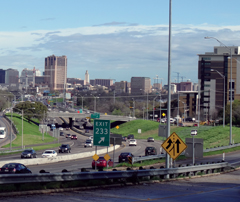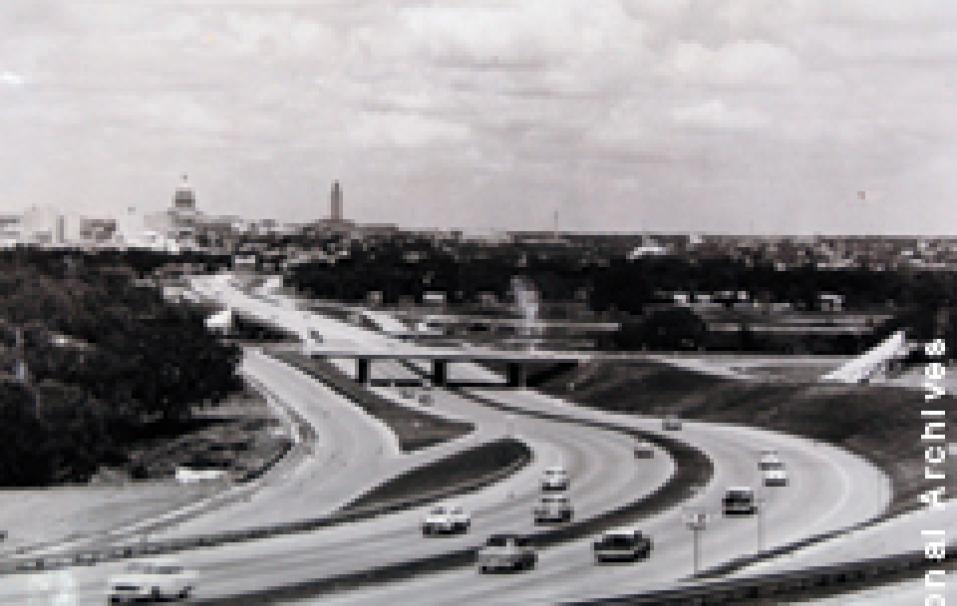By Leslie Wolfenden, THC Historic Resources Survey Coordinator
This article was originally published in the Spring 2015 issue of The Medallion.
In the 1950s, the Meridian Highway traversed Austin as US Route 81. It is now Interstate 35.
Historic American highways often conjure up images of “going west” and California Dreamin’. But traffic and aspirations weren’t limited to one direction, as the Meridian Highway proves.
Billed as North America’s first international highway, the Meridian—named for the sixth principal meridian, which it roughly follows—lives up to its title, stretching from Canada to Mexico City.

The road developed from Native American paths expanded by Spanish explorers. Portions later evolved into the Republic of Texas’ Military Road, which became a major path used to take cattle to northern markets.
In June 1911, John C. Nicholson, a Kansas lawyer and early supporter of the Good Roads Movement, spearheaded efforts to organize the International Meridian Road Association. He advocated for a permanent road to extend from Winnipeg, Canada, to Laredo and eventually to Mexico City.
Unlike most of the early trans-continental roads proposed during the early automobile era, such as the Bankhead Highway and the Lincoln Highway, the Meridian Highway extended north-south through the nation’s mid-section and crossed into Canada and Mexico. Like other early transcontinental roads, the Meridian Highway was used for commerce, trade, and tourism, but as the only major north-south route, the Meridian was the main artery for snowbirds from the north seeking warmth in the winter, as well as southerners seeking an escape from the summer heat. Ultimately, the Meridian Highway evolved into the Pan-American Highway, extending all the way to Argentina.
The Meridian Highway entered Texas at the small town of Burkburnett on the Oklahoma border. From there, the roadway headed south to Wichita Falls, Fort Worth, and to Laredo roughly parallel to present-day Interstate-35. In Waco the highway split off on what was known as the Gulf Division (along much of modern State Highway 6 and US 290) and terminated in Galveston.
In total, the Meridian Highway traveled approximately 800 miles across Texas. Its prime years of activity were from the 1920s–1960s.
The Meridian Highway Project is the second major study undertaken by the Texas Historical Commission
The former Meridian Highway that traversed Austin as US Route 81 is now Interstate 35.
(THC) and its Historic Texas Highways Program. In scope and scale, it is similar to the two-year study of the Bankhead Highway, which was conducted from 2012 to 2014. In February, the THC sponsored 10 public meetings in cities along the historic Meridian Highway alignment, including Decatur, Fort Worth, Waco, Georgetown, Bryan, San Antonio, Cotulla, Laredo, Houston, and Galveston.
“Much like the Bankhead project, our team will document all kinds of historic resources along the roadway,” says Bratten Thomason, director of the THC’s History Programs Division. “They’ll be looking for gas stations, motor courts, signs, and other kinds of roadside attractions that catered to motorists along the international roadway.”
She adds that the project will also incorporate case studies of five cities to examine development as the route evolved from a two-lane unpaved road to one of the country’s busiest interstate highways. Upon completion, the THC will announce the results of the research and survey.
The project is funded by a transportation enhancement grant awarded to the THC from the Federal Highway Administration and administered by the Texas Department of Transportation.

